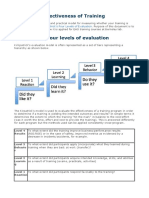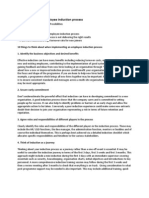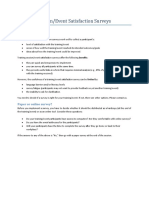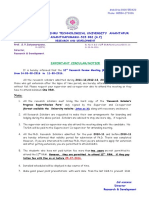Kirkpatrick Evaluation Model
Kirkpatrick Evaluation Model
Uploaded by
mysticblissCopyright:
Available Formats
Kirkpatrick Evaluation Model
Kirkpatrick Evaluation Model
Uploaded by
mysticblissOriginal Description:
Copyright
Available Formats
Share this document
Did you find this document useful?
Is this content inappropriate?
Copyright:
Available Formats
Kirkpatrick Evaluation Model
Kirkpatrick Evaluation Model
Uploaded by
mysticblissCopyright:
Available Formats
kirkpatrick's four levels of evaluation model
The four levels of Kirkpatrick's evaluation model essentially measure:
reaction of student - what they thought and felt about the training learning - the resulting increase in knowledge or capability behaviour - extent of behaviour and capability improvement and implementation/application results - the effects on the business or environment resulting from the trainee's performance
All these measures are recommended for full and meaningful evaluation of learning in organizations, although their application broadly increases in complexity, and usually cost, through the levels from level 1-4.
Quick Training Evaluation and Feedback Form, based on Kirkpatrick's Learning Evaluation Model (Excel file) kirkpatrick's four levels of training evaluation
This grid illustrates the basic Kirkpatrick structure at a glance. The second grid, beneath this one, is the same thing with more detail.
level evaluation evaluation description type and characteristics (what is measured) 1 Reaction Reaction evaluation is how the delegates felt about the training or learning experience. examples of evaluation tools and methods relevance and practicability
'Happy sheets', feedback forms. Verbal reaction, posttraining surveys or questionnaires.
Quick and very easy to obtain. Not expensive to gather or to analyse.
Learning
Learning evaluation is the measurement of
Typically assessments or tests before and after
Relatively simple to set up; clear-cut for quantifiable
the increase in knowledge - before and after.
the training.
skills.
Interview or observation Less easy for complex can also be used. learning.
Behaviour
Behaviour evaluation is the extent of applied learning back on the job - implementation.
Observation and interview over time are required to assess change, relevance of change, and sustainability of change.
Measurement of behaviour change typically requires cooperation and skill of linemanagers.
Results
Results evaluation is the effect on the business or environment by the trainee.
Measures are already in place via normal management systems and reporting - the challenge is to relate to the trainee.
Individually not difficult; unlike whole organisation. Process must attribute clear accountabilities.
kirkpatrick's four levels of training evaluation in detail
This grid illustrates the Kirkpatrick's structure detail, and particularly the modern-day interpretation of the Kirkpatrick learning evaluation model, usage, implications, and examples of tools and methods. This diagram is the same format as the one above but with more detail and explanation:
evaluation level and type 1. Reaction evaluation description and characteristics examples of evaluation tools and methods relevance and practicability
Reaction evaluation is how the delegates felt, and their personal reactions to the training or learning experience, for example: Did the trainees like and enjoy the training? Did they consider the training relevant? Was it a good use of their
Typically 'happy sheets'. Feedback forms based on subjective personal reaction to the training experience. Verbal reaction which can be noted and analysed. Post-training surveys or questionnaires. Online evaluation or grading
Can be done immediately the training ends. Very easy to obtain reaction feedback Feedback is not expensive to gather or to analyse for groups. Important to know that people were not upset or
time? Did they like the venue, the style, timing, domestics, etc? Level of participation. Ease and comfort of experience. Level of effort required to make the most of the learning. Perceived practicability and potential for applying the learning.
by delegates. Subsequent verbal or written reports given by delegates to managers back at their jobs.
disappointed. Important that people give a positive impression when relating their experience to others who might be deciding whether to experience same.
2. Learning
Learning evaluation is the measurement of the increase in knowledge or intellectual capability from before to after the learning experience: Did the trainees learn what what intended to be taught? Did the trainee experience what was intended for them to experience? What is the extent of advancement or change in the trainees after the training, in the direction or area that was intended?
Typically assessments or tests before and after the training. Interview or observation can be used before and after although this is timeconsuming and can be inconsistent. Methods of assessment need to be closely related to the aims of the learning. Measurement and analysis is possible and easy on a group scale. Reliable, clear scoring and measurements need to be established, so as to limit the risk of inconsistent assessment. Hard-copy, electronic, online or interview style assessments are all possible.
Relatively simple to set up, but more investment and thought required than reaction evaluation. Highly relevant and clearcut for certain training such as quantifiable or technical skills. Less easy for more complex learning such as attitudinal development, which is famously difficult to assess. Cost escalates if systems are poorly designed, which increases work required to measure and analyse.
3. Behaviour
Behaviour evaluation is the extent to which the trainees applied the learningand changed their behaviour, and this can be immediately and several months after the training,
Observation and interview over time are required to assess change, relevance of change, and sustainability of change. Arbitrary snapshot assessments are not reliable
Measurement of behaviour change is less easy to quantify and interpret than reaction and learning evaluation. Simple quick response systems unlikely to be
depending on the situation: Did the trainees put their learning into effect when back on the job? Were the relevant skills and knowledge used
because people change in different ways at different times. Assessments need to be subtle and ongoing, and then transferred to a suitable analysis tool.
adequate. Cooperation and skill of observers, typically linemanagers, are important factors, and difficult to control. Management and analysis of ongoing subtle assessments are difficult, and virtually impossible without a well-designed system from the beginning. Evaluation of implementation and application is an extremely important assessment - there is little point in a good reaction and good increase in capability if nothing changes back in the job, therefore evaluation in this area is vital, albeit challenging. Behaviour change evaluation is possible given good support and involvement from line managers or trainees, so it is helpful to involve them from the start, and to identify benefits for them, which links to the level 4 evaluation below.
Was there noticeable and Assessments need to be measurable change in the designed to reduce subjective activity and performance of the judgement of the observer or trainees when back in their interviewer, which is a roles? variable factor that can affect reliability and consistency of Was the change in behaviour measurements. and new level of knowledge sustained? The opinion of the trainee, Would the trainee be able to transfer their learning to another person? Is the trainee aware of their change in behaviour, knowledge, skill level? which is a relevant indicator, is also subjective and unreliable, and so needs to be measured in a consistent defined way. 360-degree feedback is useful method and need not be used before training, because respondents can make a judgement as to change after training, and this can be analysed for groups of respondents and trainees. Assessments can be designed around relevant performance scenarios, and specific key performance indicators or criteria. Online and electronic assessments are more difficult to incorporate assessments tend to be more successful when integrated within existing management and coaching protocols. Self-assessment can be useful, using carefully designed criteria and measurements.
4. Results
Results evaluation is the effect on the business or environment resulting from the improved performance of the trainee - it is the acid test. Measures would typically be business or organisational key performance indicators, such as: Volumes, values, percentages, timescales, return on investment, and other quantifiable aspects of organisational performance, for instance; numbers of complaints, staff turnover, attrition, failures, wastage, non-compliance, quality ratings, achievement of standards and accreditations, growth, retention, etc.
It is possible that many of these measures are already in place via normal management systems and reporting. The challenge is to identify which and how relate to to the trainee's input and influence. Therefore it is important to identify and agree accountability and relevance with the trainee at the start of the training, so they understand what is to be measured. This process overlays normal good management practice it simply needs linking to the training input. Failure to link to training input type and timing will greatly reduce the ease by which results can be attributed to the training. For senior people particularly, annual appraisals and ongoing agreement of key business objectives are integral to measuring business results derived from training.
Individually, results evaluation is not particularly difficult; across an entire organisation it becomes very much more challenging, not least because of the reliance on line-management, and the frequency and scale of changing structures, responsibilities and roles, which complicates the process of attributing clear accountability. Also, external factors greatly affect organisational and business performance, which cloud the true cause of good or poor results.
You might also like
- Active Training: A Handbook of Techniques, Designs, Case Examples, and TipsFrom EverandActive Training: A Handbook of Techniques, Designs, Case Examples, and TipsRating: 3.5 out of 5 stars3.5/5 (6)
- Frantic AssemblyDocument2 pagesFrantic AssemblySwati KapoorNo ratings yet
- Presentation - Addie ModelDocument35 pagesPresentation - Addie ModelOrmarial100% (2)
- Oppositional Defiant DisorderDocument56 pagesOppositional Defiant DisordermysticblissNo ratings yet
- Goodbye Stranger Chapter SamplerDocument25 pagesGoodbye Stranger Chapter SamplerRandom House TeensNo ratings yet
- Train the Trainer: Unlock your potential as a professional trainerFrom EverandTrain the Trainer: Unlock your potential as a professional trainerNo ratings yet
- Online Translator Resume SampleDocument3 pagesOnline Translator Resume SampleEmma OnwukaNo ratings yet
- Kirkpatrick Model Four Levels of Learning EvaluationDocument5 pagesKirkpatrick Model Four Levels of Learning Evaluationirnawati81100% (1)
- Introduction To The Kirkpatrick New World ModelDocument16 pagesIntroduction To The Kirkpatrick New World Modelaziznawawi100% (1)
- Instructional Module Training PlanDocument5 pagesInstructional Module Training Planapi-246767803100% (1)
- Implementing the Four Levels: A Practical Guide for Effective Evaluation of Training ProgramsFrom EverandImplementing the Four Levels: A Practical Guide for Effective Evaluation of Training ProgramsRating: 4 out of 5 stars4/5 (12)
- Instructional Delivery MethodsDocument3 pagesInstructional Delivery Methodsapi-3770163100% (4)
- Kirkpatrick ModelDocument3 pagesKirkpatrick ModelraisraheelNo ratings yet
- Measuring Training Effectiveness and Contributions To Organizational SuccessDocument39 pagesMeasuring Training Effectiveness and Contributions To Organizational SuccessAhmed YinkaNo ratings yet
- Training Needs Assessment ProcessDocument8 pagesTraining Needs Assessment Processsolkar007No ratings yet
- Training Effectiveness Evaluation ProcedureDocument14 pagesTraining Effectiveness Evaluation ProcedurenicoletabuzatuNo ratings yet
- Kirkpatrick S Training EvaluationDocument7 pagesKirkpatrick S Training Evaluationdingklaro100% (4)
- Training Evaluation MethodsDocument3 pagesTraining Evaluation MethodsSPNo ratings yet
- Facilitating Adult LearningDocument7 pagesFacilitating Adult LearningDeirdreNo ratings yet
- Transferring Learning to Behavior: Using the Four Levels to Improve PerformanceFrom EverandTransferring Learning to Behavior: Using the Four Levels to Improve PerformanceRating: 4 out of 5 stars4/5 (14)
- ARCS Model of Motivational DesignDocument2 pagesARCS Model of Motivational DesigntugionoNo ratings yet
- Evaluating Effectiveness of Training: Kirkpatrick's Four Levels of EvaluationDocument5 pagesEvaluating Effectiveness of Training: Kirkpatrick's Four Levels of EvaluationRoger Cabarles IIINo ratings yet
- Kirkpatric Training EvaluationDocument37 pagesKirkpatric Training EvaluationMadan Prabhakar100% (4)
- Motivating StudentsDocument11 pagesMotivating StudentsRho Morgan100% (1)
- PDF Micro Learning Grov o 2015Document19 pagesPDF Micro Learning Grov o 2015sbasultov100% (1)
- How To Launch An Employee Induction ProcessDocument3 pagesHow To Launch An Employee Induction ProcessSylvester SirvelNo ratings yet
- Chapter 4 Evaluation of TrainingDocument66 pagesChapter 4 Evaluation of TrainingNairita BalaNo ratings yet
- Training and DevelopmentDocument18 pagesTraining and Developments2sNo ratings yet
- 70 20 10 Into ActionDocument11 pages70 20 10 Into ActionCorporate L&D100% (1)
- Evaluation of Kirk Patrick's ModelDocument7 pagesEvaluation of Kirk Patrick's ModelRishi Bhandari100% (1)
- Adult Learning ObstaclesDocument8 pagesAdult Learning ObstaclesamitNo ratings yet
- Staff DevelopmentDocument40 pagesStaff DevelopmentJegenthambal Arumugam100% (2)
- Donald Kirkpatrick - 7 Keys To Unlock 4 Levels of EvaluationDocument4 pagesDonald Kirkpatrick - 7 Keys To Unlock 4 Levels of Evaluationinvenue100% (2)
- A PRACTICAL Guide To Training and DevelopmentDocument25 pagesA PRACTICAL Guide To Training and DevelopmentERMIYAS TARIKU100% (1)
- Training Event SatisfactionSurveyDocument9 pagesTraining Event SatisfactionSurveyJohn Pros ValenciaNo ratings yet
- Leadership Development ProgramDocument5 pagesLeadership Development ProgramMyra SollezaNo ratings yet
- 15 Principles of Experiential LearningDocument20 pages15 Principles of Experiential Learninga_steri_x2000No ratings yet
- Addie ModelDocument31 pagesAddie Modelshazlinazanudin100% (1)
- Disprz Customer Success Stories - ECommerce LMSDocument7 pagesDisprz Customer Success Stories - ECommerce LMSDisprz Com100% (1)
- Training of Trainer 1Document88 pagesTraining of Trainer 1Daksh Aneja100% (1)
- Trainer's Role and FunctionsDocument20 pagesTrainer's Role and FunctionsVISHNU.VISWAMBHARANNo ratings yet
- Adult Learning TheoriesDocument7 pagesAdult Learning TheoriesPamela Tamara Fernández EscobarNo ratings yet
- 5e's Instructional DesignDocument4 pages5e's Instructional DesignGerick Dave Monencillo VenderNo ratings yet
- Classroom ManagementDocument27 pagesClassroom ManagementKhawaja Haseeb Ur RehmanNo ratings yet
- Addie ModelDocument48 pagesAddie Modelmarkespino100% (3)
- 7 Areas of Learning and DevelopmentDocument1 page7 Areas of Learning and DevelopmentNati Rodriguez GilNo ratings yet
- Experiential LearningDocument12 pagesExperiential Learningkadafi Jimlani100% (1)
- 70-20-10 Learning Model PDFDocument5 pages70-20-10 Learning Model PDFJuan BendeckNo ratings yet
- Learning and Development AnalyticsDocument6 pagesLearning and Development Analyticsswarnpriyaswarn2366No ratings yet
- Training Measurement and Evaluation ISTDDocument51 pagesTraining Measurement and Evaluation ISTDPrasad Sawant100% (3)
- Unpacking Kirkpatrick: Data-Driven Decision Making in L&DDocument21 pagesUnpacking Kirkpatrick: Data-Driven Decision Making in L&DOlena YakovenkoNo ratings yet
- Instructional Design ProcessDocument107 pagesInstructional Design ProcessEm Yee Lee100% (2)
- The Adult Learning TheoryDocument6 pagesThe Adult Learning TheoryZosima MasangcayNo ratings yet
- Framework For Managing Learning and DevelopmentDocument38 pagesFramework For Managing Learning and DevelopmentGhansham Panwar100% (2)
- Giving and Receiving FeedbackDocument21 pagesGiving and Receiving FeedbackCharlene Waugh100% (4)
- Benchmarking: What It Is, What It Isn'tDocument6 pagesBenchmarking: What It Is, What It Isn'tSatya KumarNo ratings yet
- L&D Strategy Examples: Yelp, Google and ItsuDocument21 pagesL&D Strategy Examples: Yelp, Google and ItsuAcornNo ratings yet
- Outcome-Based Experiential Learning: Let's Talk About, Design For, and Inform Teaching, Learning, and Career DevelopmentFrom EverandOutcome-Based Experiential Learning: Let's Talk About, Design For, and Inform Teaching, Learning, and Career DevelopmentNo ratings yet
- ADDIE SampleDocument16 pagesADDIE SampleMuhamad Ridzuan100% (2)
- Competency-Based LNADocument41 pagesCompetency-Based LNACarlo Fajardo100% (1)
- Faculty Development Gap AnalysisDocument43 pagesFaculty Development Gap AnalysisRiry Ambarsary100% (1)
- Effective Training & Developing Employees. Organization BehaviorDocument35 pagesEffective Training & Developing Employees. Organization BehaviorMuhammad D. Hossain Mak0% (1)
- The Evaluation of Learning and Development in The WorkplaceDocument30 pagesThe Evaluation of Learning and Development in The Workplacejohar77660% (1)
- Group Psycho For AnerexiaDocument12 pagesGroup Psycho For AnerexiamysticblissNo ratings yet
- Different Models of CurriculumDocument17 pagesDifferent Models of CurriculumBeethovenMark100% (1)
- Assignment Part 1.3Document1 pageAssignment Part 1.3mysticblissNo ratings yet
- Connected Writing and Disconnected WritignsDocument2 pagesConnected Writing and Disconnected WritignsmysticblissNo ratings yet
- Assignment Part 1.4Document2 pagesAssignment Part 1.4mysticblissNo ratings yet
- 10 Social Media Tips For Local News OrganisationsDocument7 pages10 Social Media Tips For Local News OrganisationsmysticblissNo ratings yet
- Pitru Dosh Quick RemedyDocument2 pagesPitru Dosh Quick RemedymysticblissNo ratings yet
- Graphology QuizDocument2 pagesGraphology QuizmysticblissNo ratings yet
- Choosing Correct End PunctuationDocument4 pagesChoosing Correct End PunctuationmysticblissNo ratings yet
- Dick and Carey Model: Additional InformationDocument2 pagesDick and Carey Model: Additional InformationmysticblissNo ratings yet
- Editing Skills: Before Writing The StoryDocument2 pagesEditing Skills: Before Writing The StorymysticblissNo ratings yet
- Developing A Traing ProgramDocument28 pagesDeveloping A Traing ProgrammysticblissNo ratings yet
- Instructional Design TheoriesDocument17 pagesInstructional Design TheoriesmysticblissNo ratings yet
- Gagne Learning PrinciplesDocument2 pagesGagne Learning PrinciplesmysticblissNo ratings yet
- Addie ModelDocument3 pagesAddie ModelmysticblissNo ratings yet
- Graphic Signs of The Schizoid and Other Signs in MurdersDocument14 pagesGraphic Signs of The Schizoid and Other Signs in MurdersmysticblissNo ratings yet
- Workshop - Emotional IntelligenceDocument1 pageWorkshop - Emotional IntelligencemysticblissNo ratings yet
- What Are Scaled Scores?Document2 pagesWhat Are Scaled Scores?mysticblissNo ratings yet
- English 1 Lesson Plan Self, FamilyDocument5 pagesEnglish 1 Lesson Plan Self, FamilyLenith PitogoNo ratings yet
- Https CCMT - Nic.in CCMTRegistration Result DownloadLetter - Aspx#Document1 pageHttps CCMT - Nic.in CCMTRegistration Result DownloadLetter - Aspx#MadhuNo ratings yet
- 2016 SSHD Research ContributionsDocument3 pages2016 SSHD Research ContributionsJay GutierrezNo ratings yet
- Comprehensive Report (Sample)Document10 pagesComprehensive Report (Sample)Godfather 么 HacksNo ratings yet
- Safe Work Procedure in Cold SawDocument1 pageSafe Work Procedure in Cold SawCyril AngkiNo ratings yet
- Gmail - JLPT (December) - 2024Document1 pageGmail - JLPT (December) - 2024Pranauv ManikandanNo ratings yet
- Level FourDocument23 pagesLevel FourTajmohammad ZarifNo ratings yet
- 5 Honesty and IntegrityDocument16 pages5 Honesty and IntegrityfffffNo ratings yet
- Edu TestDocument15 pagesEdu Testtitusmunikwa2001No ratings yet
- Barrall Irene Business Partner b2 Workbook Answer KeyDocument6 pagesBarrall Irene Business Partner b2 Workbook Answer Keytwojs100No ratings yet
- Naclo 2016 Round 1Document25 pagesNaclo 2016 Round 1NNMNo ratings yet
- Self Reflection AssignmentDocument27 pagesSelf Reflection Assignmentecurtin1No ratings yet
- English S5 TGDocument168 pagesEnglish S5 TGWhat I watched100% (1)
- For Details See Prospectus: TM - Telugu Medium EM - English Medium UM - Urdu MediumDocument1 pageFor Details See Prospectus: TM - Telugu Medium EM - English Medium UM - Urdu MediumMukesh BishtNo ratings yet
- Code SwitchingDocument40 pagesCode SwitchingRizki Maulana SahabNo ratings yet
- 7 - Simple Raspberry Pi CourseDocument12 pages7 - Simple Raspberry Pi CourseJeanpaul MilaniNo ratings yet
- Qmul Dissertation GuidelinesDocument6 pagesQmul Dissertation GuidelinesBuyCheapPapersOnlineSingapore100% (1)
- Natalie Gacek ResumeDocument1 pageNatalie Gacek ResumeErin BakerNo ratings yet
- Local Media252192014281482340Document45 pagesLocal Media252192014281482340Nicole ColdwellNo ratings yet
- PoetryDocument3 pagesPoetryapi-284926564No ratings yet
- Information Security Adherence in Institutions of Higher Education: A Case Study of American University of NigeriaDocument10 pagesInformation Security Adherence in Institutions of Higher Education: A Case Study of American University of NigeriajournalNo ratings yet
- The Recruiter HandbookDocument86 pagesThe Recruiter Handbooktou01100% (1)
- Looking For Previous Year IAS PapersDocument10 pagesLooking For Previous Year IAS PapersEazhil ManivannanNo ratings yet
- IMR 604 Documenting Oral Tradition: Faculty of Information Management University Technology MaraDocument42 pagesIMR 604 Documenting Oral Tradition: Faculty of Information Management University Technology MaraNur AthifahNo ratings yet
- CH 7-Organizational EntryDocument20 pagesCH 7-Organizational EntryHina Khan100% (1)
- DLP English Class Playgroup T1 W4 AY 2024-25Document10 pagesDLP English Class Playgroup T1 W4 AY 2024-25Alishba AliNo ratings yet
- Jntua R&D PHD M.phil Ms 12th RRM Important Circular DT 08th Aug 2016 To 11th Aug 2016.Pdf - 205001Document3 pagesJntua R&D PHD M.phil Ms 12th RRM Important Circular DT 08th Aug 2016 To 11th Aug 2016.Pdf - 205001nims1964No ratings yet












































































































